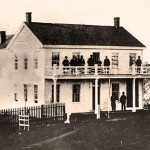Did Mother Damnable—aka Mary Ann Boyer, Seattle’s original hard-ass—really turn to stone after her death in 1873?
By Bess Lovejoy, The Seattle Stranger
Mary Ann Boyer was a foul-mouthed woman of the sea. In the 1850s, she sailed with Captain David “Bull” Conklin on his whaling ship off Alaska, until he got tired of her nagging and abandoned her in Port Townsend. She made her way to the tiny village of Seattle and began running the Felker House, Seattle’s first hotel, a two-story structure at Jackson Street and First Avenue South whose pieces had been carried here in the hold of a ship. And after she died, Boyer’s bones soaked in the flooded earth of the old Seattle Cemetery. When they dug her up, the undertaker discovered that her body had turned to stone.

That’s the legend, anyway.
The real Mary Ann Boyer exists only in the scrawls of old census records, scattered accounts from early historians, and the reminiscences of an old admiral. The woman peering out from the balcony of the Felker House in a photo taken around 1868—a small, stout figure in voluminous petticoats—might be her, but we don’t know for sure. The Felker House, which some say was also a brothel, burned down in the Great Fire of 1889. Today, the city’s only mark of her is a grave in Lake View Cemetery, a flat headstone placed close to a road, supposedly because the men couldn’t carry her petrified body any farther.
They say she kept rocks in her apron to throw at people, and that she cursed constantly in five languages—English, French, Spanish, Portuguese, and Chinese, plus a smattering of German. That’s partly how she earned her nickname: Mother Damnable.
There are two main stories told of her life, and both involve her yelling at men. In 1854, Seattle’s territorial government held a lynching trial at her hotel, transforming her rooms into a makeshift court. They racked up a large bill for food and lodging, but when the prosecuting attorney demanded a receipt, Boyer flew into a rage. She filled her arms with wood for her stove and began hurling pieces of it at the lawyer, shouting, “You want a receipt, do you? Well, here it is!” As the pioneers told it, no one ever asked her for a receipt again.
The second story dates from the days when the US Navy’s Decatur was anchored in Elliott Bay, protecting settlers from hostile Native Americans. As part of their efforts to defend the settlement, the men of the Decatur tried to clear a new road through town. But every time they passed the Felker House, trouble met them in the form of Mother Damnable. (Some say the bushes they tried to chop down were essential for protecting the privacy of her establishment.) In his memoirs, the lieutenant of the Decatur, Thomas S. Phelps, called Boyer a “demon in petticoats” and “a terror to our people, who found her tongue more to be dreaded than the entire Indian army recently encamped in our front.”
Phelps describes his encounter with the “demon” this way: “The moment our men appeared upon the scene, with three dogs at her heels, and an apron filled with rocks, this termagant would come tearing from the house, and the way stones, oaths, and curses flew was something fearful to contemplate, and, charging like a fury, with the dogs wild to flesh their teeth in the detested invaders, the division invariably gave way before the storm, fleeing, officers and all, as if old Satan himself was after them.”
After several aborted attempts, the ship’s quartermaster, a man named Sam Silk and “a veritable old-time salt,” according to Phelps, confronted Boyer. When his speech about the necessity of the road was cut short by a torrent of abuse and a piece of wood aimed at his head, he changed his tack.
“What do you mean, you damned old harridan, raising hell this way? I know you, you old curmudgeon,” he said. “Many’s the time I’ve seen you howling thunder around Fell’s Point, Baltimore. You’re a damned pretty one, ain’t you?”
As Phelps tells it, “The effect was magical. With one glance of concentrated hatred at Silk, she turned and flew like the wind, scattering sticks and rocks on all sides, and, with her yelping dogs, disappeared within the house, never again to be seen by one of the Decatur‘s crew.”
This anecdote is one of the better pieces of evidence that Boyer was indeed a madam (she didn’t exactly keep public records). An article in the Pacific Northwest Quarterly by MOHAI’s public historian, Lorraine McConaghy, notes that Fell’s Point was then Baltimore’s red-light district. McConaghy also points out that Phelps compares Boyer to “a prototypical Madame Damnable, a Frenchwoman living at Callao, a seaport in Peru, who seems to have run a bordello there.”
In fact, while historians usually say Boyer’s nickname stemmed from her filthy language, the truth is more complex. The phrase “Mother Damnable” dates back at least to the mid-17th century in England; there’s a ballad called “Mother Damnable’s Ordinary” recorded by the London Stationers’ Registry in July 1656. According to the folklorist Steve Roud, a “flurry of mentions” of Mother Damnables occur around that time, and the term always refers to a madam or a witch. (It’s worth noting that settlers referred to Boyer as “Mother” or “Madam.”) When the settlers of Seattle dubbed Mary Ann “Damnable,” they probably weren’t just making reference to her foul mouth, but placing her within a particular tradition of unpleasant women.
Boyer’s unpleasantness, of course, is part of why everyone loves the story of her turning to stone. It seems like divine retribution, proof that God has a sense of humor. And yet the transformation also seems to prove that her stubbornness, her hard-as-nails attitude, carried on past the grave. While the rest of the city’s pioneer dead fell victim to worms, she grew ever more impenetrable.
And the tour guides, guidebooks, historians, and librarians who repeat this story aren’t making it up.
The tale goes back to undertaker Oliver C. Shorey, who founded what later became the funeral home Bonney-Watson, now the city’s oldest continually operating business. In 1884, Shorey got the contract to dig up the bodies from the old Seattle Cemetery, which was being turned into Denny Park. (The cemetery was known for flooding, leading the coffins to bob around in the ground and turning the bodies black.) In a Seattle Post-Intelligencer article from August 22, 1884, Shorey describes what happened when he dug up Boyer:
We discovered that the coffin was very heavy, weighing at least 400 pounds and it took six men to lift it out of the grave. On removing the lid to the coffin we found that she had turned to stone. Her form was full sized and perfect, the ears, finger nails and hair being all intact. Her features were, however, somewhat disfigured. Covering the body was a dark dust, but after that was removed the form was as white as marble and as hard as stone.
Shorey’s description makes no mention of the smile that some say beamed from Boyer’s face, and which makes her preserved body seem like that of an incorruptible saint. It’s also worth noting that he describes her coffin as weighing at least 400 pounds, not the 2,000 that is sometimes recorded. But the real question is, could she really have turned to stone?
It seems highly unlikely, given that she was underground for only 11 years. It’s more probable that her body was coated with adipocere, a substance sometimes called “grave wax” that can develop when fat decomposes in wet soil. Adipocere is not uncommon, and is often described as gray or white, although it’s usually a bit softer than stone—more like clay, plastic, or cheese. Yes, corpse cheese.
Shorey’s description of what he saw might also have been influenced by a peculiar 19th-century craze. When his shovel bit into the dirt of the Seattle Cemetery in 1884, reports of petrified corpses had been in the newspapers for years. The most famous case came in 1869, when two laborers discovered what appeared to be a 10-foot-tall stone giant buried on a farm in Cardiff, New York. (“I declare,” one of them yelled out, “some old Indian has been buried here!”)
The 3,000-pound “giant” was in fact a hoax perpetrated by a New York cigar maker named George Hull. An avowed atheist, Hull had recently gotten into an argument with a Methodist revivalist who claimed that giants had once walked the earth (hey, it’s in the Bible). Hull had decided to create his own giant out of gypsum, telling the men who cut the stone from a quarry near Fort Dodge that it was for a memorial to Abraham Lincoln. He swore everyone else involved to silence, and buried the figure on his cousin’s farm.
Sure enough, after the discovery, the townspeople beat a path to the farm, and Hull started charging admission. Before long, he’d sold the giant to a group of businessmen, who successfully fended off interest from P. T. Barnum. (When his offer was refused, Barnum made an exact copy and exhibited it in a New York museum. The new owner of the real fake giant, one David Hannum, supposedly coined the phrase “There’s a sucker born every minute” in reference to those who paid to see Barnum’s copy.)
Supposedly, Barnum even eventually tried to buy Boyer’s body.
A rash of copycat petrified corpses followed, made of substances such as limestone, concrete, and hardened gelatin. Even Mark Twain got into the act. The October 4, 1862, issue of Nevada’s Territorial Enterprise carried an article by Twain (then Samuel Clemens) “reporting” the discovery of a petrified man in the mountains south of Gravelly Ford. Apparently, every limb and feature of the fossilized man was perfect, “not even excepting the left leg, which has evidently been a wooden one during the lifetime of the owner.” Even though the “stony mummy” was described as having his “right thumb resting against the side of the nose” (that is, thumbing his nose), most of the newspapers that reprinted the story gave no hint that it was a hoax, encouraging the discovery of other petrified people across the land.
Such tales may go back to an 1858 hoax in the Daily Alta California, in which a letter from a local doctor described the misadventures of a prospector named Ernest Flucterspiegel, who turned to stone after drinking the fluid inside a geode. (Apparently, the man’s heart resembled red jasper.) Even newspapers of the early 20th century described petrified corpses, although, strangely, it’s not something you hear much about today. The 1860s were a time of intense interest in human origins (Charles Darwin’s The Origin of Species was published in 1859), and many of the early petrified corpses were described as mind-bogglingly ancient. One, with the stub of a tail, was even briefly thought to be evolution’s “missing link.” Embalming also started in earnest in America only after the Civil War, and it’s possible that some undertakers weren’t used to seeing the condition of embalmed remains. In any case, Boyer’s petrifaction story reads vaguely like a fairy tale, and it secured her an immortality she might not otherwise have enjoyed.
Yet another story has it that Mary Ann Boyer was never moved at all, and she still rests beneath the grass at Denny Park. However, Shorey’s yellowed reburial register (kept at the Seattle Municipal Archives) records her removal in his careful cursive. Other records show that Boyer’s body was moved to the old Washelli Cemetery—which later became Volunteer Park—and then in 1887 to Lake View Cemetery, where she continues her slow decay today.
That is, unless she really did turn to stone.
Bess Lovejoy is a writer and researcher in Seattle. She reads from her new book, Rest in Pieces: The Curious Fates of Famous Corpses, on Tues March 12, Rendezvous JewelBox Theater, 2322 Second Ave, 7 pm, free, 21+.
















